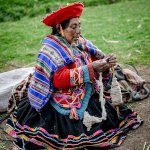Pachamama Raymi in Peru and Ecuador Date in the current year: August 1, 2026
 Pachamama Raymi is an annual traditional festival celebrated in some parts of Ecuador and Peru. On August 1 each year, locals express their gratitude to Mother Earth.
Pachamama Raymi is an annual traditional festival celebrated in some parts of Ecuador and Peru. On August 1 each year, locals express their gratitude to Mother Earth.“Pachamama Raymi” is literally translated from Quechua as “Mother Earth feast”, since “Pachamama” stands for “Mother Earth” and raymi stands for “feast” (like in Inti Raymi). Veneration of Mother Earth is an ancient Andean tradition that dates back to before the Spanish contest of the Americas. The Inca people, for example, considered Mother Earth as a goddess who made sure that people were fed and protected, and the main purpose of Pachamama Raymi was to give thanks to her.
The feast of Pachamama Raymi is celebrated in the Ecuadorian province of Zamora-Chinchipe and in the Cusco Region of Peru. On the first day of the festival, August 1, Peruvian and Ecuadorian farmers halt all the work on their fields to give the earth a chance to rest. They also take various crops, cook them and give them back to Mother Earth as an offering, putting the food in a hole in the ground as a way of feeding Pachamama, which is considered hungry this time of the year. The ceremony is performed by an Andean priest called “Pako”.
In addition, to express their gratitude to Mother Earth, Peruvians and Ecuadorians perform traditional songs and dances. Alongside traditional rituals, the celebration of Pachamama Raymi includes a textile exhibition, bullfights, and other events and activities that attract tourists from all other the world, giving them a chance to immerse themselves in traditional Andean culture.
Although many locals don’t believe in ancient gods anymore, they still celebrate Pachamama Raymi because it is an important part of their culture. During the festival, they perform the traditional ritual to thank the nature for all its gifts, which so many people take for granted, and promote harmony between man and nature.
Interestingly, the Pachamami Raymi festival gave name to a methodology for rural development that was developed in 1988 in Cusco. The Pachamama Raymi methodology is used in Latin America and even some parts of Europe to combat extreme poverty in rural communities and environmental degradation resulting from it.
The methodology makes it possible to introduce innovations in agriculture and natural resource management by mobilizing local population to take charge of their own welfare. It uses contests between families living in the same village or between several villages located in the same district to encourage villagers to introduce innovations largely through their own means. The participants compete in introducing the required innovations for a cash prize.
A contest usually lasts for about half a year, and it takes five to eight successive contests to achieve sustainable results in the region. These contests reinforce villagers’ cultural identity, bring families and communities closer together, and create a festive spirit in the village, just like the annual Pachamami Festival that the methodology was named after.
- Category
- Cultural Observances, Folk Festivals
- Country
- Peru, Ecuador
- Tags
- Pachamama Raymi in Peru and Ecuador, holidays in Peru, holidays in Ecuador, traditional festivals, Mother Earth festival